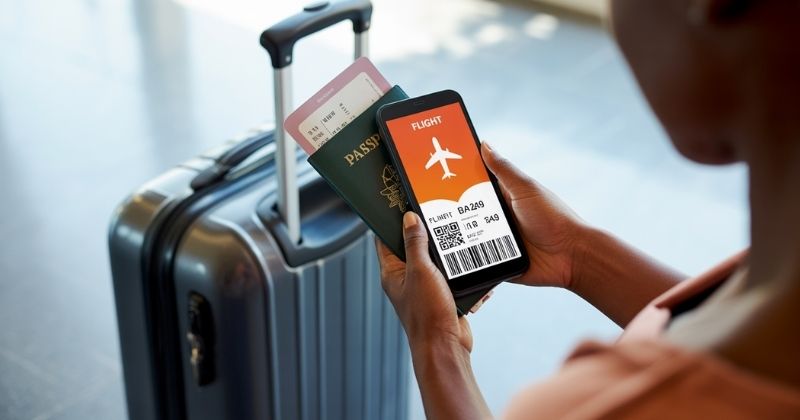
Airports around the world, including those in South Africa, may soon see a major shift in how passengers travel. A new set of international regulations is being developed with the aim of replacing traditional travel documents such as passports and boarding passes with a secure, smartphone-based system. This move signals a major disruption in how international travel has been managed for decades, paving the way for a bold new era of frictionless airport experiences.
Key Takeaways
- Digital Travel Credentials (DTCs) May Replace Physical Passports: The International Civil Aviation Organisation (ICAO) is pushing for a smartphone-based system that could allow South Africans and global travellers to move through airports without showing physical passports or boarding passes.
- Biometric and Cryptographic Security: The DTC uses facial recognition and cryptographic verification to authenticate identity, combining digital convenience with strong security protocols. This system can streamline airport processes while reducing fraud.
- The System Will Be Optional and Coexist with Traditional Documents: While DTCs promise faster and more efficient travel, physical passports will still be required for the foreseeable future. Travellers can opt in or continue using existing documentation.
About Arcadia Finance
Arcadia Finance makes loan applications simple. Choose from 19 trusted, NCR-registered lenders, with no application fees, no hassle, and reliable options designed to suit your financial goals.
ICAO Proposes the Use of Digital Travel Credentials
The International Civil Aviation Organisation (ICAO), the global authority for civil aviation standards, has introduced a proposal to adopt a new form of identification known as the Digital Travel Credential (DTC). This credential would serve as a comprehensive replacement for both passports and boarding passes, creating a more seamless travel experience for passengers. If implemented successfully, the DTC could make queues at airport counters and delays caused by lost documents a thing of the past.
The DTC is designed to merge physical and digital security elements into a single system, making it both efficient and resistant to fraud. According to ICAO, the DTC consists of two main components: the Virtual Component and the Physical Component. Each serves a specific function in verifying the traveller’s identity and maintaining the authenticity of the data. With cyber threats on the rise, ICAO’s emphasis on cryptographic verification ensures a high level of data integrity and protection against forgery.
The DTC Virtual Component (DTC-VC) is a secure, digital replica of a passport’s key data. It is cryptographically tied to the issuing government authority, using digital signatures to confirm the integrity and origin of the information. This ensures that the data has not been changed and remains authentic throughout the journey.
This means airport staff and immigration officers can verify a traveller’s identity in real-time, making for quicker and more accurate checks.
The DTC Physical Component (DTC-PC) acts as the medium that carries this digital credential. In most cases, this will take the form of a mobile application or smart device which securely stores the digital data and presents it at checkpoints. Travellers will no longer need to shuffle through wallets or bags, as their identity will be in their pocket, ready to scan and go.
With digital travel documents set to take over, having a valid ID is more essential than ever. Learn where to apply for a South African ID online so you can stay ahead in the age of smart travel.

Biometric Verification to Enhance Identity Checks
Travellers using the DTC will have the ability to confirm their identity through facial recognition technology embedded in their smartphone. This biometric verification will be used at various points throughout the journey, reducing the need to manually present documentation. Once active, this system would allow travellers to pass through both departure and arrival airports without physically showing any form of travel document. Such innovation not only eliminates touchpoints but also enhances hygiene and pandemic preparedness, a priority in a post-Covid era.
Faster Processing and Fraud Reduction
ICAO maintains that the implementation of the DTC will significantly speed up processing times at airports while also reducing the risk of identity fraud. The agency believes that by digitising identity and automating verification, border checks can become both faster and more secure, with minimal disruption to legitimate passengers. Authorities will be able to identify high-risk individuals earlier, allowing them to focus resources where they’re most needed.
The ongoing changes at South African airports highlight the growing challenges for international travellers. Our guide on South African Passport Holders Face New Setback explores how these shifts affect citizens planning overseas trips and what measures can help navigate the hurdles.
Simplifying a Complicated Travel Process
Andy Smith, a Subject Matter Expert for Border Management, Immigration, and Security solutions, pointed out that modern travel has become increasingly complex, often requiring multiple identity checks, visas, and travel authorisations. He said the intention behind the DTC is to simplify the process by allowing passengers to handle much of their documentation before they even arrive at the airport. This approach aims to reduce time pressure and streamline the entire travel experience. The result? More time for travellers to relax, less time spent fumbling with paperwork, and fewer chances for last-minute surprises.
Creating a Secure Digital Passport Linked to Authorisations
A key feature of the DTC is the ability to store a secure, digital passport on the traveller’s smartphone. This passport can be linked to any relevant visas or electronic travel permissions. With this system, passengers can verify they have everything they need before departure, helping reduce stress and delays during check-in and immigration. Essentially, your entire travel identity is consolidated into one secure device, and that changes everything about how we move across borders.
According to Smith, travellers can expect a much smoother journey, both at their home airport and upon arrival at their destination. He believes the combination of pre-clearance and automated identity checks will lead to a simplified and faster airport experience. Gone are the days of fumbling for boarding passes or facing long delays at immigration; digital identity promises an express-lane experience for the modern flyer.
As identity verification becomes increasingly digital, knowing which FICA documents are required for identity verification can help travelers navigate new systems more smoothly, whether boarding flights or opening new financial accounts.
Digital Travel Will Be Optional
While the move to digital identity is expected to benefit most travellers, the use of DTCs will remain entirely voluntary. Smith emphasised that passengers who prefer traditional documents can continue using them. The new system will rely on modern smartphones capable of facial recognition and chip-reading technology, meaning not everyone may be able or willing to adopt it. This hybrid approach ensures that no traveller is left behind, regardless of their comfort with technology.
Smith acknowledged that not all travellers will have access to suitable technology, and some may prefer human assistance. The travel industry, he said, will continue to accommodate those who require additional help at airports and border controls. Airlines, airports, and immigration officials will be expected to maintain services for these travellers while also managing digital verification for others. This parallel system guarantees inclusivity and avoids alienating passengers who rely on traditional support services.
Although some physical security checks will still be required, Smith said the industry is increasingly relying on automation and intelligence to improve speed without compromising safety. He highlighted that the aviation sector remains a frequent target of organised crime, making it essential to maintain effective yet efficient security procedures. Intelligent systems now enable real-time risk analysis, helping authorities respond to threats with far greater speed and accuracy.

Earlier Verification Will Strengthen Immigration Control
One of the key benefits of the DTC system is that immigration authorities will be able to access verified data earlier in the travel process. This means security checks and immigration decisions can happen before the passenger even arrives at their destination airport, reducing processing times upon arrival. This advance clearance capability could drastically shorten long immigration queues and even allow for dedicated fast lanes for pre-verified digital travellers.
According to Smith, enabling individuals to securely control and share their personal data with authorities is crucial to the success of the DTC system. Passengers will have full control over when and with whom their information is shared, helping balance convenience with privacy concerns. This puts power back into the hands of travellers, making privacy a key pillar of the future of international mobility.
Physical Passports Still Required for Now
Although the DTC marks a major advancement in travel facilitation, ICAO has stated that physical passports will continue to be required for many years to come. This is due to existing international agreements and border requirements, as well as the need for a backup in case of technical issues with digital systems. For the foreseeable future, travellers will still need to carry traditional documents, even as the digital revolution gathers momentum.
Conclusion
The introduction of the Digital Travel Credential signals a major shift in how international air travel could function in the coming years. With facial recognition, secure mobile apps, and cryptographic authentication, this system promises to make airport experiences faster, safer, and more efficient. However, it will remain optional and won’t replace physical passports entirely just yet, giving travellers the choice between traditional documents and a more tech-driven alternative.
Fast, uncomplicated, and trustworthy loan comparisons
At Arcadia Finance, you can compare loan offers from multiple lenders with no obligation and free of charge. Get a clear overview of your options and choose the best deal for you.
Fill out our form today to easily compare interest rates from 19 banks and find the right loan for you.



